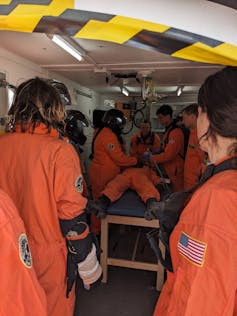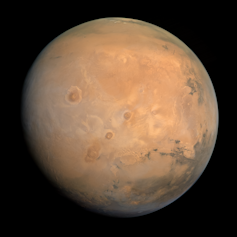In the coming decade, more people will go to space than ever before as human spaceflight enters a new era. NASA, the European Space Agency and other governmental agencies are partnering to develop crewed missions beyond the Moon. At the same time, these agencies are collaborating with private companies using new technologies to drive down the price of space exploration.
Companies such as SpaceX, Blue Origin and Sierra Space have developed vehicles with reusable boosters, automated flight systems and lightweight materials to support these deep space missions. Some even have ambitions of their own to build private space stations, Moon bases or mining operations in the coming decades.
But as these technologies and partnerships rapidly make spaceflight more accessible, new challenges emerge. For one, maintaining the health and performance of an astronaut crew. My team of researchers and educators at the University of Colorado and others around the world are looking to address this issue.

With spaceflight set to expand, astronauts will need access to medical care over longer voyages and on commercial flights.
Katya Arquilla
Emerging medical challenges in space
NASA astronauts are some of the most accomplished people on the planet, and they’re some of the healthiest. Astronauts undergo extensive medical and psychological testing that in one study disqualified 26% of final-round applicants. This rigorous screening and testing process effectively limits the chance of a medical event occurring during a mission.
But as spaceflight becomes more accessible, astronaut crews on commercial missions will likely make up the majority of space travelers in the coming years. Private missions will be short and stay in a close orbit around Earth in the near term, but private crews will likely have less training and more chronic medical conditions than the professional astronauts currently living and working in space.
While experiments aboard the International Space Station have extensively studied the normal physiological changes occurring to the human system in weightlessness, there is limited to no data about how common chronic diseases such as diabetes or high blood pressure behave in the space environment.

During Mars missions, astronauts will be away from Earth for long periods of time, with limited access to medical resources.
CU/LASP EMM/EXI ITF/Kevin M. Gill, CC BY
This industry boom is also creating opportunities for long-duration missions to the Moon and Mars. Because of the length of missions and the distance from Earth, professional astronauts on these missions will experience prolonged weightlessness, leading to bone and muscle loss, communication delays of a few seconds up to 40 minutes, and extreme isolation for months to years at a time.
Crews must function autonomously, while being exposed to new hazards such as lunar or Martian dust. Because of the fuel…



